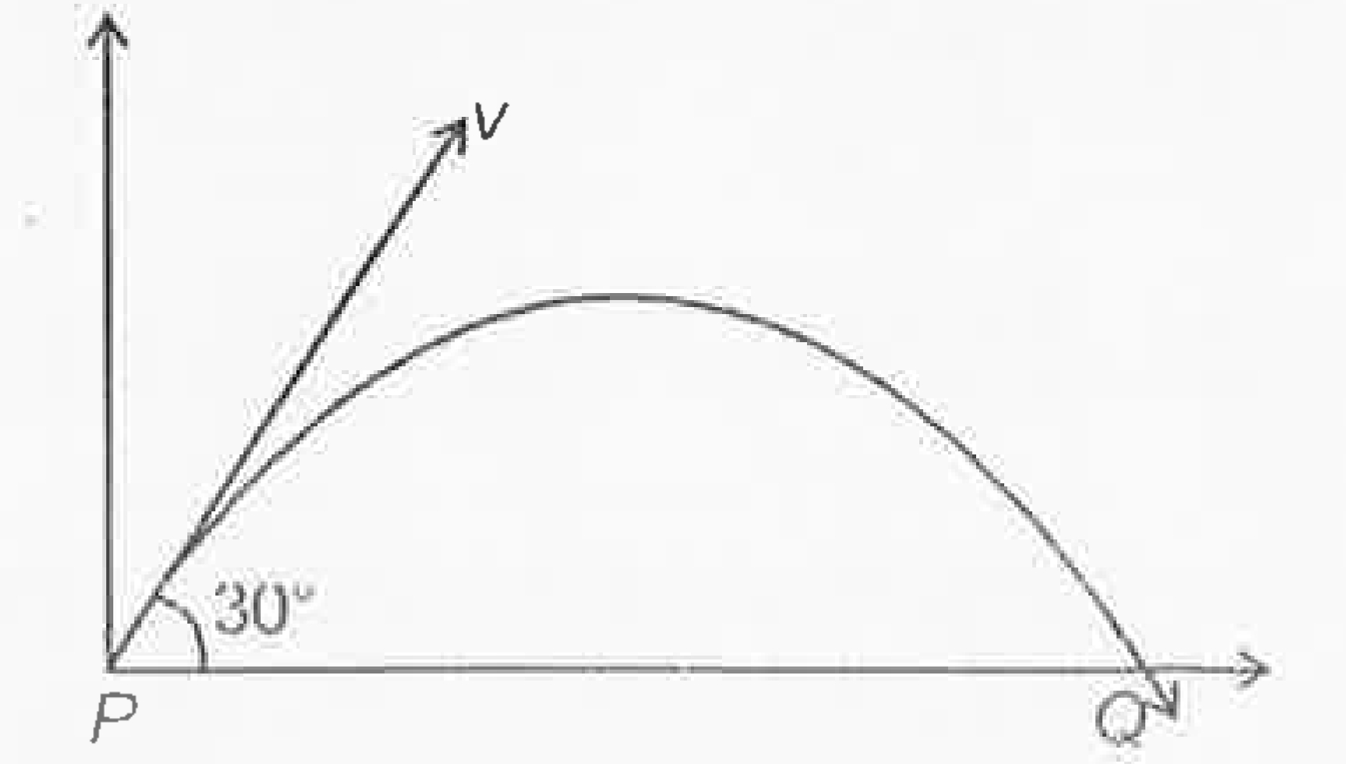A projectile of mass m is fired into a liquid at an angle θ0 with an initial velocity v0 as shown. If the liquid develops a frictional or drag resistance on the projectile which is proportional to its velocity, i. e. F=−kv where k is a positive constant, determine the x and y components of its velocity at any instant. Also find the maximum distance xmax that it travels?

The correct Answer is:A, C
ax=dvxdt=−kvcosθm=−kmvx
∴dvxvx=−kmdtor∫vxv0cosθ0dvxvx=−km∫t0dt
or vx=v0cosθ0e−kmt …(i)

Similarly,
ay=dvydt=−kvsinθm−g=−(kmvy+g)
or ∫vyv0sinθ0dvykmvy+g=−∫t0dt
or mk[ln(kmvy+g)]vyv0sinθ0=−t
or (kmvy+g)(kmv0sinθ0+g)=e−kmt
or vy=mk[(kmv0sinθ0+g)e−kmt−g] ...(ii)
(b) Eq. (i) can be written as
dxdt=v0cosθ0e−kmt
or ∫x0dx=v0cosθ0∫t0e−kmtdt
or x=(m v_0 cos theta_0)/k [1-e^(-k/m t)]<br>orx_m=(m v_0 cos theta_0)/k<br>att=oo
Topper's Solved these Questions
- KINEMATICSBook:DC PANDEY ENGLISHChapter:KINEMATICSExercise:SCQ_TYPE
Explore 39 Videos
- KINEMATICSBook:DC PANDEY ENGLISHChapter:KINEMATICSExercise:MCQ_TYPE
Explore 23 Videos
- KINEMATICSBook:DC PANDEY ENGLISHChapter:KINEMATICSExercise:Comprehension
Explore 7 Videos
- GRAVITATIONBook:DC PANDEY ENGLISHChapter:GRAVITATIONExercise:(C) Chapter Exercises
Explore 45 Videos
- KINEMATICS 1Book:DC PANDEY ENGLISHChapter:KINEMATICS 1Exercise:INTEGER_TYPE
Explore 15 Videos
Similar Questions
A projectile is fired from the origin with a velocity v0 at an angle θ with x-axis. The speed of the projectile at an altitude h is .
View SolutionThe system of mass A and B shown in the figure is released from rest with x=0, determine the velocity of mass B when x=3m. Also find the maximum displacement of mass B.

View SolutionThe force acting on a particle moving along X-axis is F=−k(x−v0t) where k is a positive constant. An observer moving at a constant velocity v0 along the X-axis looks the particle . What kind of motion does he find for the particle?
View SolutionA small particle of mass m is projected at an angle θ with the x- axis with an initial velocity v0 in the x−yplane as shown in the figure . At a time t<v0sinθg, the angular momentum of the particle is
where ˆi,ˆjandˆk are unit vectors along x,yandz - axis respectively.

View SolutionA projectile of a mass m is fired with velocity v from point a as shown in figure neglecting air resistance, what is the change in momentum in x direction when leaving from P and arriving at Q?

View SolutionA body of mass m is thrown straight up with velocity v0(v0<<ve) Find the velocity v with which the body comes down if the air drag equals kv2, where k is a positive constant and v is the velocity of the body.
View SolutionA projectile is fired with an initial velocity of 240 m/s at a target B located 600 m above the gun A and at a horizontal distance of 3600 m. Neglecting air resistance, determine the value of the firing angle θ .

View SolutionA projectile is fired with velocity.v0 at an angle 60∘ with horizontal . At top of its trajectory it explodes into two fragments of equal mass. If one fragment retraces the path then the speed of the other fragment is
View SolutionA body of mass m travels in a straight line with a velocity v=kx3/2 where k is a constant. The work done in displacing the body from x=0 to x is proportional to:
View SolutionA ball is thrown upward with an initial velocity V0 from the surface of the earth.The motion of the ball is affected by a drag force equal to mγv2 (where m is mass of the ball, v is its instantaeous velocity and γ is a constant).Time taken by the ball to rise to its zenith is :
View Solution